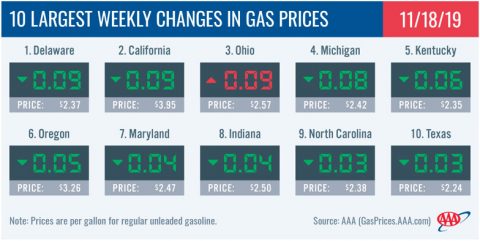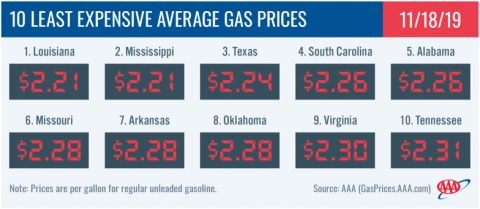 Tampa, FL – On the week, gas prices are mostly cheaper across the country. A small number of states saw pump prices decrease more than a dime, though the majority saw fluctuation of a few pennies. Today’s national average of $2.59 is two cents cheaper than last week.
Tampa, FL – On the week, gas prices are mostly cheaper across the country. A small number of states saw pump prices decrease more than a dime, though the majority saw fluctuation of a few pennies. Today’s national average of $2.59 is two cents cheaper than last week.
“An increase in gasoline stocks amid robust demand helped to push gas prices cheaper on the week,” said Jeanette Casselano, AAA spokesperson.

“We would expect this trend to continue throughout most of the month, but the exception is Thanksgiving. With nearly 49.3 million Americans expected to travel by car for the holiday, gas prices may start to fluctuate by the end of this week,” Casselano stated.
Today’s national average is six cents less than last month and three cents cheaper than this time last year.
Quick Stats
- The nation’s top 10 largest weekly changes are: Delaware (-9 cents), California (-9 cents), Ohio (+9 cents), Michigan (-8 cents), Kentucky (-6 cents), Oregon (-5 cents), Maryland (-4 cents), Indiana (-4 cents), North Carolina (-3 cents) and Texas (-3 cents).
- The nation’s top 10 least expensive markets are: Louisiana ($2.21), Mississippi ($2.21), Texas ($2.24), South Carolina ($2.26), Alabama ($2.26), Missouri ($2.28), Arkansas ($2.28), Oklahoma ($2.28), Virginia ($2.30) and Tennessee ($2.31).
Great Lakes and Central States
Pump price volatility continues across the Great Lakes and Central States. Four states landed on the top 10 list of largest pump price changes in the country: Ohio (+9 cents), Michigan (-8 cents), Kentucky (-6 cents) and Indiana (+4 cents). However, most states in the region saw gas prices decrease by one to three cents. In addition to Ohio and Indiana, Illinois and South Dakota also saw gas price increases, though only by one cent.
While Illinois ($2.65) carries the highest pump price average in the region, most state averages range from $2.35 – $2.55.
Gasoline stocks saw a build of nearly 400,000, driving stocks up to 46.9 million bbl. According to Energy Information Administration (EIA) data, this was the first regional increase in stocks since the end of September. Should stocks continue to increase – and at sizable amounts – motorists would likely see gas prices decline.
South and Southeast
Gas prices range from $2.51 in New Mexico to $2.21 in Louisiana. On the week, prices are cheaper in all South and Southeast states. Texas ($2.24), Oklahoma ($2.28), Tennessee ($2.31) and Florida ($2.36) saw the largest decreases in the region at three cents.
Regional refinery utilization jumped to 89.7% according to EIA’s data for the week ending November 8th. That is the highest rate for any region in the country. With the increase in rates, stocks increased to 78.5 million. This combination helped to drive gas prices cheaper in the last week. Prices are likely to continue to decrease in the weeks ahead.
Mid-Atlantic and Northeast
Compared to a year ago, the Mid-Atlantic and Northeast region is seeing some of the largest savings at the pump. Connecticut (-22 cents), Rhode Island (-21 cents), Massachusetts (-18 cents), New Hampshire (-18 cents), New York (-18 cents) and Vermont (-17 cents) all land on the top 10 list for the biggest year-over-year change in gas prices.
On the week, only Washington, D.C. (+2 cents) saw gas prices increase. Delaware (-9 cents) saw the largest decline, followed by Maryland (-4 cents) and North Carolina (-3 cents). Gas prices range from $2.30 – $2.75.
Despite the large increase in stocks the week prior, the latest EIA data shows stocks holding mostly stable at 59.3 million bbl. The regional refinery utilization rate performed similarly, sitting steady at 90%. The stability in stocks and utilization assisted in keeping regional price pump jumps relatively small.
Rockies
Gas prices only increased as much as a penny on the week in the region and only for Colorado ($2.79) and Wyoming ($2.73). Pump prices held steady in Montana ($2.70), Utah ($2.91) and Idaho ($2.99).
Gas prices in the region may decrease in the week ahead due to increasing stock levels and rising refinery utilization. In EIA’s latest data, stocks increased 200,000 to 6.9 million bbl, while refinery rates jumped from 81.2% to 86.4%.
West Coast
Pump prices in the West Coast region have decreased on the week after the region underwent planned and unplanned refinery maintenance that caused prices to spike over the past month. Reduced supply in the region, amid robust demand, put pressure on pump prices in prior weeks, but the pressure continues to decrease as a result of imports and increased production from regional refineries. As supply increases, prices will likely continue to drop throughout the region this week.
California ($3.95) and Hawaii ($3.65) are the most expensive markets in the country. Washington ($3.38), Nevada ($3.35), Oregon ($3.26), Alaska ($3.19) and Arizona ($2.94) follow. California (-9 cents) and Oregon (-5 cents) saw the largest decreases in the region, while Alaska (+1 cent) saw the only increase on the week.
The EIA report for the week ending November 8 showed that total West Coast gasoline stocks increased from 26.19 million bbl to 26.60 million bbl. The current level is approximately 100,000 bbl lower than last year’s level at this time.
Oil Market Dynamics
At the close of Friday’s formal trading session on the NYMEX, WTI increased by 95 cents to settle at $57.72. Crude prices increased last week due to increased optimism that China and the U.S. – the world’s two largest crude consumers – are continuing to resolve ongoing trade tensions that sparked market fears that global crude demand would suffer as a result of increased tariffs between both countries.
Crude prices increased despite new data from EIA that revealed total domestic crude inventories increased by 2.2 million bbl, bringing the new total to 449 million bbl. The current level is 6.9 million bbl higher than last year’s level at this same time.
Motorists can find current gas prices along their route with the free AAA Mobile app for iPhone, iPad and Android. The app can also be used to map a route, find discounts, book a hotel and access AAA roadside assistance. Learn more at AAA.com/mobile.






